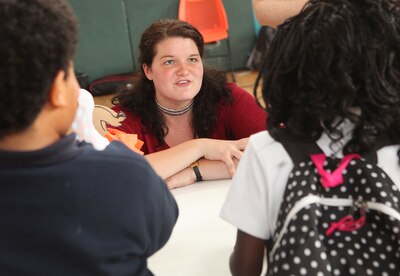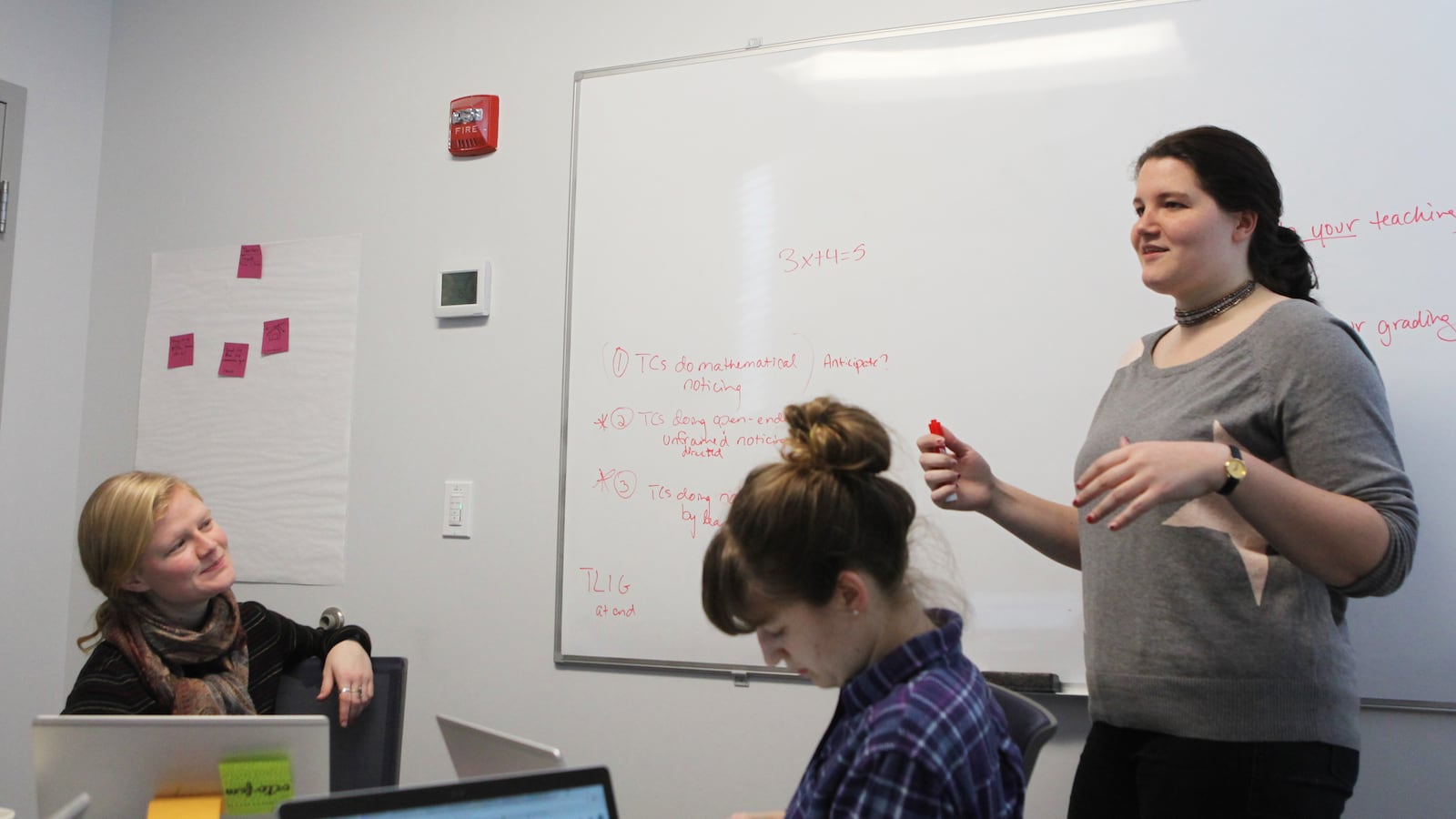Imagine you’re a new teacher. You overhear two students disparaging Black Lives Matter protests, and know that other students heard it, too. You’re worried the comments will damage your classroom culture.
“What are you going to do in the exact moment? What do you do in the next month to make sure your classroom is a safe environment?”
Asking those questions is Rupal Jain of the Woodrow Wilson Academy of Teaching and Learning, a soon-to-launch graduate school of education with a new approach to teaching teachers. The Academy’s goal is not just to challenge them with scenarios like that one, but to ensure they master them, with prospective teachers moving at their own pace and graduating when they demonstrate more than 40 specific skills.
The future of education will “move away from focusing on what you’re being taught to what you’ve actually learned,” said Arthur Levine, the former president of Teachers College and the head of the Woodrow Wilson Foundation, the organization behind the Academy. “We thought, let’s create an institution that does it and can model it.”
The Academy, which will focus on preparing math and science teachers, is taking shape in partnership with MIT and with the support of major education funders. It recently netted a $3 million donation from the Chan Zuckerberg Initiative, the organization tasked with doling out the Facebook founder’s billions.
It amounts to a combination of two major efforts in American education: long-running attempts to improve teacher training to soften the on-the-job learning curve, and the newer effort to “personalize” education using technology and other means.
It’s unclear if it will work: “Competency-based” teacher education has a thin track record, and though research has been done on the teaching fellowships the Woodrow Wilson Foundation has run for the last decade, the foundation has not released it. But the Academy has the funding, prestige, and handle on the zeitgeist to suggest that its approach will influence teacher education in the years ahead.
What is the Academy?
Walk into the Academy headquarters today — an office in a nondescript building on MIT’s campus in Cambridge — and you’ll see evidence of furious brainstorming: Post-its, scribbled notes on whiteboards, a big concept map that staff members call their compass.
That work is a result of a partnership announced in 2015 between the Woodrow Wilson National Fellowship Foundation and MIT, which has attached an elite name to the endeavor and whose researchers are helping construct the curriculum.
The next two years were spent fundraising and sketching out how the program might work. Woodrow Wilson has raised $22 million from the Chan Zuckerberg Initiative, the Bezos Foundation, the Bill and Melinda Gates Foundation, and Carnegie Corporation of New York, among several other funders, and plans to raise $10 million more. (Chalkbeat is also supported by Gates and Carnegie.)
This year, 10 “design fellows,” mostly recent college graduates, are helping develop the program by serving as enthusiastic guinea pigs and idea generators.
The idea of building something new appealed to Alex Trunnell, who recently graduated from Vassar with a degree in physics and astronomy. Recently, she spent time trying to design ways to prepare teachers to ensure a classroom runs smoothly.
“How do you avoid any kind of hardship that isn’t grappling with the content?” she asked. “We realized that there is no right way to do those things. We can’t teach you the one right way to set up your classroom because it doesn’t exist.”
Instead, the Academy is creating a sort of teaching “gym” for aspiring teachers to practice, with activities and 3D software for designing a classroom space, for example.
The design fellows also visit schools once a week and work directly with students during after-school programs. And they’re using a simulation program known as “Mursion” for practicing classroom scenarios.
The inaugural class of of around 25 teacher candidates will start this fall. The Academy plans to ramp up to admit 50, then 75, and then 100 students by the 2021-22 school year.
But its goal is much larger in scope than producing new teachers. It’s to serve as a proving ground for a novel way of teaching teachers.

The model’s challenges
To work, the Academy will need to successfully assess the skills it expects prospective teachers to master. That’s a tall order, particularly before teachers actually have their own classrooms.
Staff at the Academy say they plan to measure those skills repeatedly and in a number of ways, including written exams, virtual simulations of classrooms, and real-life student teaching situations. Still, certain context-specific skills, like being able to develop strong relationships with students, will always be challenging to gauge.
“We don’t have assessments yet that really assess the quality of those kinds of practices,” said Pam Grossman, the dean of the University of Pennsylvania school of education and a member of the Academy’s advisory board.
Another hurdle may be the funding model. Rather than charging based on the number of courses taken, the Academy plans to charge a set fee of $25,000 per student (with discounts based on student need) no matter how long it takes for someone to complete the program. The Academy will have to sell prospective students on that uncertainty — and keep students on track for its own financial sustainability.
“Every time I talk to my parents about this program it really freaks them out. It’s a hard thing to get your mind around, this idea that I don’t know when I’ll finish up,” said Trunnell. (She and the other design fellows will be able to enroll for free once the program launches later this year.) “For me, it’s actually really nice, because it’s this idea that I’m going to be done when I’m prepared and ready to be a good teacher.”
No research on Woodrow Wilson’s other teaching program
The Woodrow Wilson Foundation has been involved in teacher preparation for years, but its track record is unclear.
Its teaching fellowship, which launched in 2007, has partnered with universities in a number of states to train math and science teachers. Like the Academy, the fellowship aspired to “transform teacher education while preparing future leaders in the teaching profession,” according to its website.
We don’t know how well that effort worked, though. Despite contracting with the American Institutes for Research to study its fellowship, Woodrow Wilson has not released any external research about its fellowship programs.
A person with direct knowledge of a draft of a study of the fellowship in Michigan said it found that, on average, the Woodrow Wilson “fellows’ performance is about equal with the performance of comparable non-fellow teachers.”
The person spoke on the condition of anonymity because the findings are subject to a confidentiality agreement. (A spokesperson for Woodrow Wilson confirmed the existence of a nondisclosure agreement with AIR.)
Levine said he’s waiting for longer-term results from multiple states, and promised to release the research at some point in the future. Levine says that the Academy will also open itself up to careful study.
“What we’re waiting for is to bring this to a completion,” he said of the fellowship research. “I want real results before I start boasting or criticizing ourselves for them.” (The Foundation has, in two reports, though, claimed some success based on that research without releasing the full studies.)
The lack of publicly available information about the foundation’s long-running programs raises questions about the organization’s commitment to transparency.
Grossman, the University of Pennsylvania dean, said that, more broadly, it’s crucial to have careful studies on what is and isn’t working as teacher training programs try new things.
“We really need to be generating the research that adds to the knowledge base about what’s effective in teacher education,” she said. “And that means making the results of these studies public.”
If you build it, will others adopt it?
Let’s imagine that everything goes right with the Academy: it designs and executes its program well, it recruits full classes of new students each year, and it releases rigorous research showing that its graduates are successful in the classroom.
In that case, it will still be preparing just a hundred or so new teachers each year — even as public schools look to hire roughly 250,000 teachers annually and employ more than three million total teachers. To realize its goal, the Academy needs to be able to diffuse its approach widely.
Levine says that’s what they’re planning to do. “Everything we create is going to be open source,” he said. “The goal here is for this not be thought of as a competitor with traditional teacher ed providers — our goal is for this to be thought of as a resource center.”
That means some of Woodrow Wilson’s success will depend on whether the rest of the teacher prep world is interested in the Academy’s work and whether larger schools of education can put its simulations, games, and curriculum materials into use.
Ken Zeichner, a professor at the University of Washington who has been critical of some of the new teacher prep programs like Relay, said a lack of resources and expertise to implement a new approach had been the downfall of competency-based teacher education in the 1970s.
“These innovations are created, and you have all these universities that have not had the capacity to be able to implement the innovations that are being created,” he said.
There’s also the question of whether Levine — who has criticized existing teacher education programs for some time — is the right ambassador.
Levine says he’s not worried. “I may have been a critic, but I’m a critic who basically loves them,” he said. “There’s no example of us walking into an ed school and people saying, ‘Oh my God, you’re that monster!’”
Grossman says the Academy is more likely to be successful if it does not position itself as having all the answers. “Not, ‘We’re going to develop this and you can all learn from us,’ but ‘We’re in this together. We’re all trying to do some things to improve the quality of teacher education,’” she said.


